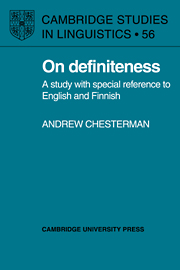Book contents
- Frontmatter
- Contents
- Acknowledgements
- 1 Introduction
- 2 English articles: the research traditions
- 3 English article usage
- 4 A unified description of the English articles
- 5 Finnish: no articles
- 6 Finnish spesies
- 7 The status of definiteness in Finnish
- 8 English and Finnish contrasted
- 9 Wider perspectives
- References
- Author index
- Subject index
3 - English article usage
Published online by Cambridge University Press: 18 September 2009
- Frontmatter
- Contents
- Acknowledgements
- 1 Introduction
- 2 English articles: the research traditions
- 3 English article usage
- 4 A unified description of the English articles
- 5 Finnish: no articles
- 6 Finnish spesies
- 7 The status of definiteness in Finnish
- 8 English and Finnish contrasted
- 9 Wider perspectives
- References
- Author index
- Subject index
Summary
Noun classes
A comprehensive description of the articles must obviously incorporate answers to the following two questions:
(a) Which kinds of nouns may in principle take which article(s)?
(b) Under what circumstances may – or must – a given noun or noun type take a given article?
For any given noun, that is, we must be able to specify first which articles are possible out of context, and then which of the possible articles is the appropriate one within a given context.
The first of these questions has to do with the classification of noun types. Before considering the distribution of the articles in context, then, a brief discussion of the relevant noun classes will be in order.
What modern standard grammars (such as Quirk et al. 1972, 1985) refer to as the count/mass distinction derives largely from the ideas of scholars such as Jespersen and Christophersen. Jespersen (1949) distinguished ‘mass-words’ from ‘unit-words’ on the grounds that mass-words take both the zero article and the, whereas unit-words (in the singular) cannot take zero; both these are distinct from proper names, which take (what he called) zero only. Earlier (in volume II), Jespersen had used the terms ‘countables’ and ‘uncountables’: i.e. the opposition was then defined semantically, having to do with whether or not a given concept could be counted.
- Type
- Chapter
- Information
- On DefinitenessA Study with Special Reference to English and Finnish, pp. 41 - 62Publisher: Cambridge University PressPrint publication year: 1991



